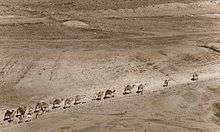Definify.com
Webster 1913 Edition
camel
cam′el
(kăm′ĕl)
, Noun.
[OE.
camel
, chamel
, OF. camel
, chamel
, F. chameau
L. camelus
, fr. Gr. κάμηλος
; of Semitic origin; cf. Heb. gāmāl
, Ar. jamal
. Cf. As. camel
, fr. L. camelus
.] 1.
(Zool.)
A large ruminant used in Asia and Africa for carrying burdens and for riding. The camel is remarkable for its ability to go a long time without drinking. Its hoofs are small, and situated at the extremities of the toes, and the weight of the animal rests on the callous. The dromedary (
Camelus dromedarius
) has one hump on the back, while the Bactrian camel (Camelus Bactrianus
) has two. The llama, alpaca, and vicuña, of South America, belong to a related genus (Auchenia
). 2.
(Naut.)
A water-tight structure (as a large box or boxes) used to assist a vessel in passing over a shoal or bar or in navigating shallow water. By admitting water, the camel or camels may be sunk and attached beneath or at the sides of a vessel, and when the water is pumped out the vessel is lifted.
Camel bird
(Zool.)
, the ostrich.
– Camel locust
(Zool.)
, the mantis.
– Camel’s thorn
(Bot.)
, a low, leguminous shrub (
Alhagi maurorum
) of the Arabian desert, from which exudes a sweetish gum, which is one of the substances called manna.Webster 1828 Edition
Camel
CAMEL
,Noun.
1.
A large quadruped used in Asia and Africa for carrying burdens, and for riders. As genus, the camel belongs to the order of Pecora. The characteristics are; it has no horns; it has six fore teeth in the under jaw; the canine teeth are wide set, three in the upper and two in the lower jaw; and there is a fissure in the upper lip. The dromedary of Arabian camel, has one bunch on the back, four callous protuberances on the fore legs and two on the hind legs. The Bactrian camel has two bunches on the back. The Llama of South America is a smaller animal, with a smooth back, small head, fine black eyes, and very long neck. The Pacos or sheep of Chili his no bunch. Camels constitute the riches of an Arabian, without which he could neither subsist, carry on trade nor travel over sandy desarts. Their milk is his common food. By the camels power of sustaining abstinence rom drink, for many days, and of subsisting on a few coarse shrubs, he is peculiarly fitted for the parched and barren lands of Asia and Africa.2.
In Holland, Camel, [or Kameel, as Coxe writes it,] is a machine for lifting ships, and bearing them over the Pampus, at the mouth of the river Y, or over other bars. It is also used in other places, and particularly at the dock in Petersburg, to bear vessels over a bar to Cronstadt.Definition 2025
camel
camel
English

A camel, Camelus bactrianus.

Camels convoy in Jordan Rift Valley
Noun
camel (plural camels)
- A beast of burden, much used in desert areas, of the genus Camelus.
- A light brownish color, like that of a camel.
-
camel colour:
-
- Loaded vessels lashed tightly, one on each side of a another vessel, and then emptied to reduce the draught of the ship in the middle.
Synonyms
- (mammal): oont (India)
Coordinate terms
- (Camelids) camelid; camel (dromedary, Bactrian camel), llama, guanaco, alpaca, vicuna/vicuña (Category: en:Camelids)
Derived terms
Derived terms
Related terms
Translations
beast of burden
|
|
See also
Adjective
camel (not comparable)
- Of a light brown color like that of a camel.
- 1999, New Woman (volume 29, page 212)
- […] try to select accessories that are in the same color family as your coat," says millinery designer Patricia Underwood. To pick up the weave of a brown tweed jacket, for instance, choose a camel hat and black gloves.
- 1999, New Woman (volume 29, page 212)
Anagrams
Old French
Etymology
Noun
camel m (oblique plural cameus, nominative singular cameus, nominative plural camel)